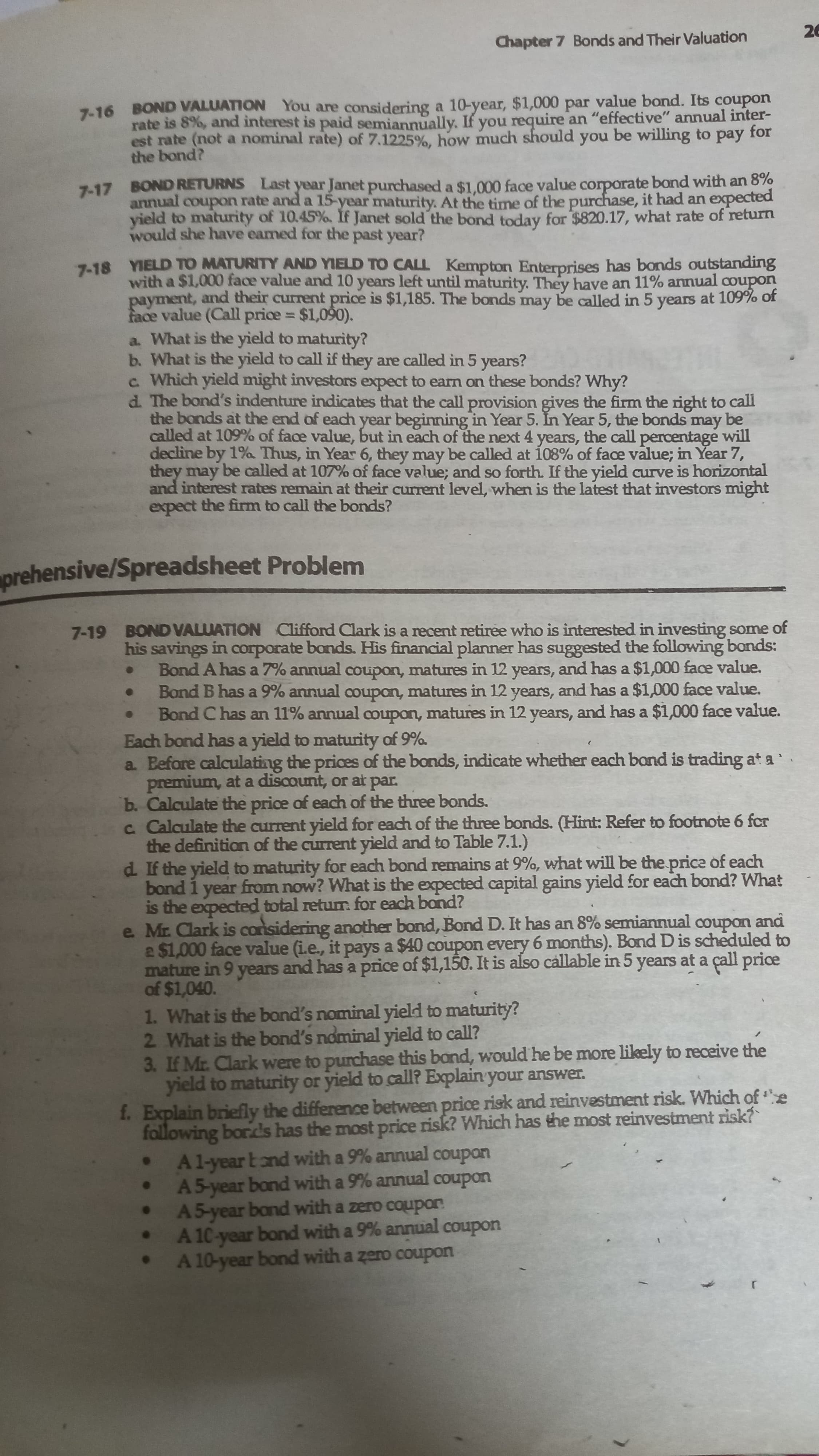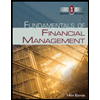f. Explain briefly the difference between price risk and reinvestment risk. Which of e following bords has the most price risk? Which has the most reinvestment risk? A1-year tond with a 9% arnual coupon A5-year bond with a 9% annual A5-year band with a zero coupon A 10-year bond with a 9% annual coupon A 10-year bond with a zero coupon coupon
f. Explain briefly the difference between price risk and reinvestment risk. Which of e following bords has the most price risk? Which has the most reinvestment risk? A1-year tond with a 9% arnual coupon A5-year bond with a 9% annual A5-year band with a zero coupon A 10-year bond with a 9% annual coupon A 10-year bond with a zero coupon coupon
Chapter5: The Cost Of Money (interest Rates)
Section: Chapter Questions
Problem 18PROB
Related questions
Question
7-19 ....part f

Transcribed Image Text:Chapter 7 Bonds and Their Valuation
7-16 BOND VALUATION You are considering a 10-year, $1,000 par value bond. Its coupon
rate is 8%, and interest is paid semiannually. If you require an "effective" annual inter-
est rate (not a nominal rate) of 7.1225%, how much should you be willing to pay for
the bond?
7-17 BOND RETURNS Last year Janet purchased a $1.000 face value corporate bond with an 8%
annual couporn rate and a 15-year maturity. At the time of the purchase, it had an expected
yield to maturity of 10.45%. If Janet sold the bond today for $820.17, what rate of return
would she have eamed for the past year?
7-18 YIELD TO MATURITY AND YIELD TO CALL Kempton Enterprises has bonds outstanding
with a $1,000 face value and 10 years left until maturity. They have an 11% annual couporn
payment, and their current price is $1,185. The bonds may be called in 5 years at 109% of
face value (Call price $1,090).
a. What is the yield to maturity?
b. What is the yield to call if they are called in 5 years?
c Which yield might investors expect to earn on these bonds? Why?
d. The bond's indenture indicates that the call provision gives the firm the right to call
the bonds at the end of each year beginning in Year 5. In Year 5, the bonds may be
called at 109% of face value, but in each of the next 4 years, the call percentage will
decline by 1%a Thus, in Year 6, they may be called at 108% of face value; in Year 7,
they may be called at 107% of face value; and so forth. If the yield curve is horizontal
and interest rates remain at their current level, when is the latest that investors might
expect the firm to call the bonds?
%3D
prehensive/Spreadsheet Problem
7-19 BONDVALUATION Clifford Clark is a recent retiree who is interested in investing some of
his savings in corporate bonds. His financial planner has suggested the following bonds:
Bond A has a 7% annual coupon, matures in 12 years, and has a $1,000 face value.
Bond B has a 9% annual coupon, matures in 12 years, and has a $1,000 face value.
Bond C has an 11% annual ooupon, matures in 12 years, and has a $1,000 face value.
Each bond has a yield to maturity of 9%.
a Before calculating the prices of the bonds, indicate whether each bond is trading at a
premium, at a discount, or at par.
b. Calculate the price of each of the three bonds.
c Calculate the current yield for each of the three bonds. (Hint: Refer to footnote 6 fcr
the definition of the current yield and to Table 7.1.)
d. If the yield to maturity for each bond remains at 9%, what will be the price of each
bond 1 year from now? What is the expected capital gains yield for each bond? What
is the expected total retum. for each bond?
e Mr. Clark is considering another bond, Bornd D. It has an 8% semiannual ooupon and
a $1,000 face value (ie., it pays a $40 coupon every 6 months). Bond D is scheduled to
mature in 9 years and has a price of $1,150. It is also callable in 5 years at a çall price
of $1,040.
1. What is the bond's nominal yield to maturity?
2 What is the bond's nominal yield to call?
3. If Mr. Clark were to purchase this bond, would he be more likely to receive the
yield to maturity or yield to call? Explain your answer.
f. Explain briefly the difference between price risk and reinvestment risk. Which of e
following bords has the most price risk? Which has the most reinvestment risk?
A1-year Eond with a 9% annual coupon
• A5-year bond with a 9% annual coupon
. A5-year bond with a zero coupon
. A 10-year bond with a 9% annual coupon
A 10-year bond with a zero coupon
Expert Solution
This question has been solved!
Explore an expertly crafted, step-by-step solution for a thorough understanding of key concepts.
This is a popular solution!
Trending now
This is a popular solution!
Step by step
Solved in 3 steps with 2 images

Knowledge Booster
Learn more about
Need a deep-dive on the concept behind this application? Look no further. Learn more about this topic, finance and related others by exploring similar questions and additional content below.Recommended textbooks for you


Fundamentals of Financial Management (MindTap Cou…
Finance
ISBN:
9781285867977
Author:
Eugene F. Brigham, Joel F. Houston
Publisher:
Cengage Learning

Fundamentals of Financial Management, Concise Edi…
Finance
ISBN:
9781285065137
Author:
Eugene F. Brigham, Joel F. Houston
Publisher:
Cengage Learning


Fundamentals of Financial Management (MindTap Cou…
Finance
ISBN:
9781285867977
Author:
Eugene F. Brigham, Joel F. Houston
Publisher:
Cengage Learning

Fundamentals of Financial Management, Concise Edi…
Finance
ISBN:
9781285065137
Author:
Eugene F. Brigham, Joel F. Houston
Publisher:
Cengage Learning

Fundamentals of Financial Management, Concise Edi…
Finance
ISBN:
9781305635937
Author:
Eugene F. Brigham, Joel F. Houston
Publisher:
Cengage Learning

Fundamentals Of Financial Management, Concise Edi…
Finance
ISBN:
9781337902571
Author:
Eugene F. Brigham, Joel F. Houston
Publisher:
Cengage Learning